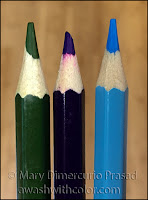This card is a Clean and Simple (CAS) design featuring Rubbernecker Stamps - "Watercolor Wine Bottle." They are known for their awesome watercolor stamps. This is a two part stamp - very easy to use, although I recommend using a stamp platform or positioner to get the alignment perfect. I paired it with a fun sentiment.
Affiliate links may be included in this post. I participate in the Amazon Services LLC Associates Program, an affiliate advertising program that provides a means for me to earn fees by linking to Amazon.com and affiliated sites at no cost to you. This helps offset a small portion of my crafting addiction... uh, hobby. See notice at bottom of blog for a longer description.
Making the Card
1. I used Color Burst pigment powders in Lamp Black and Merlot to color my image. Carefully add a little of each color to a palette (or different areas of a craft mat). Add a little water with a watercolor brush - but not too much; you want it to stick to the stamps. Mount the outline of the bottle and glass to a stamp platform (or positioner), brush with Lamp Black, and stamp on watercolor paper. Important: pay attention to the glass bottom and stem - leave enough room around the image for die cutting. Clean stamp with water and remove.
2. Use a slightly wet brush on the image to move some of the black around in a few places. This will give it more of a "watercolor look."
3. Use the stamp press or positioner to position then stamp the splashing wine, using Merlot Color Burst. I recycled a sheet of clear plastic packaging to use in my stamp platform for positioning. I stamp on the plastic first (using regular ink) with the plastic butted up against one corner, leaving room around the stamp area for positioning. See above photo. Next I line up the paper under it, remove the plastic (I use magnets to hold the paper), and stamp. Use a slightly wet brush to fill in any gaps (e.g. if the paper is textured). You may want to add more color from the palette. Once dry, die cut with second largest stitched rectangle.
4. Cut white cardstock 4 1/4 x 11 inches; fold in half to form a 4 1/4 x 5 1/2 inch top folding card base.
5. Die cut burgundy cardstock with largest stitched rectangle. Adhere to card base. Adhere stamped image to this.
6. Using VersaMark Ink or other embossing ink, stamp Wine a Little on vellum. Emboss in black. Trim down, leaving extra space on the right for tails. Mark a light dot in the middle of the right side, as far in as you want the tails cut. Cut from the corners to this dot to form tails. Adhere to card where shown by using small dots of glue (I use Multi Medium Matte) behind the letters; put a weight on it until dry (couple minutes).
7. To make the stars, use Sizzix Triplits Stars dies by Stephanie Barnard. I didn't have any black or wine colored glitter paper so I made my own using black cardstock, glitter, and double-sided adhesive. Add double-sided adhesive to both sides of a piece of cardstock (large enough for some stars). Die cut stars (I used the smallest die for two and the next size up for one). Remove backing from one side of each, dip them in glitter, and burnish with your finger. I used Bright Cranberry on one of the smallest stars and Basic Black on the other two. Optional: the Bright Cranberry didn't match perfectly so I used a B99 Copic Marker to gently color over the glitter, giving it a more wine color. Adhere stars as shown.
8. Adhere black enamel dots where shown. I used Beacon Gem-Tac for this. Note: For the smallest dot, I used Nuvo Crystal Drops in Ebony Black for the smallest dot; you could use this for all three as well.
Supplies
- Stamping Watercolor Paper Uncoated 110# (Rubbernecker Stamps)
- Rubbernecker Stamps: Watercolor Wine Bottle (974), Wine a Little (640-04)
- Rubbernecker Dies: Nested Rectangle Small Stitch Die Cut Set (5013D)
- Color Burst (Lamp Black, Merlot)
- VersaMark Ink or Other Embossing Ink Pad
- Black Embossing Powder
- Translucent Vellum
- Cardstock: Burgundy, White (e.g. Neenah Classic Crest Solar White), Black
- Heat Tool
- Watercolor Brush
- Optional: Stamp Platform (e.g. Tim Holtz/Tonic Studios Stamp Platform) or Positioning Tool
- Optional: Embossing Magic or Powder Tool
- Star Dies: Sizzix Triplits Stars (661118)
- ECD Silk Microfine Glitter: Basic Black (601) and Bright Cranberry (657)
- Double Sided Adhesive
- Optional: Copic Marker B99
- Enamel Dots: Black
- Beacon Gem-Tac
- Nuevo Crystal Drops: Ebony Black





















